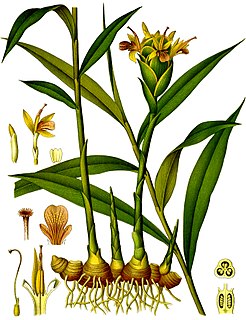
Zingiberaceae or the ginger family is a family of flowering plants made up of about 50 genera with a total of about 1600 known species of aromatic perennial herbs with creeping horizontal or tuberous rhizomes distributed throughout tropical Africa, Asia, and the Americas. Many of the family's species are important ornamental, spice, or medicinal plants. Ornamental genera include the shell gingers (Alpinia), Siam or summer tulip, Globba, ginger lily (Hedychium), Kaempferia, torch-ginger Etlingera elatior, Renealmia, and ginger (Zingiber). Spices include ginger (Zingiber), galangal or Thai ginger, melegueta pepper, myoga, korarima, turmeric (Curcuma), and cardamom.

Boesenbergia rotunda, commonly known as Chinese keys, fingerroot, lesser galangal or Chinese ginger, is a medicinal and culinary herb from China and Southeast Asia. In English, the root has traditionally been called fingerroot, because the shape of the rhizome resembles that of fingers growing out of a center piece.

The genus Zingiber is native to Southeast Asia especially in Thailand, China, the Indian Subcontinent, and New Guinea. It contains the true gingers, plants grown the world over for their medicinal and culinary value. The most well known are Z. officinale and Z. mioga, two garden gingers.

Curcuma alismatifolia, Siam tulip or summer tulip is a tropical plant native to Laos, northern Thailand, and Cambodia. Despite its name, it is not related to the tulip, but to the various ginger species such as turmeric. It can grow as an indoor plant, and is also sold as a cut flower.

Curcuma is a genus of plants in the family Zingiberaceae that contains such species as turmeric and Siam tulip. They are native to Southeast Asia, southern China, the Indian Subcontinent, New Guinea and northern Australia. Some species are reportedly naturalized in other warm parts of the world such as tropical Africa, Central America, Florida, and various islands of the Pacific, Indian and Atlantic Oceans. Generally, most curcuma grows well in loose and sandy soil in shaded areas.

Amomum is a genus of plants native to China, the Indian subcontinent, Southeast Asia, New Guinea, and Queensland. It includes several species of cardamom, especially black cardamom. Plants of this genus are remarkable for their pungency and aromatic properties.

Kai Larsen was a Danish botanist.

Elettaria cardamomum, commonly known as green or true cardamom, is a herbaceous, perennial plant in the ginger family, native to southern India. It is the most common of the species whose seeds are used as a spice called cardamom. It is cultivated widely in tropical regions and reportedly naturalized in Réunion, Indochina, and Costa Rica.

Tripogon is a genus of tropical and subtropical plants in the grass family. They are widespread across Asia, Africa, Australia, and the Americas. Fiveminute grass is a common name for plants in this genus.

Cautleya is a small genus of perennial plants of the family Zingiberaceae, found in the eastern Himalayas through to China and Vietnam. It consists of two species of high-altitude tropical and temperate plants, native to cool forest areas – an unusual habitat for members of the Zingiberaceae. They are grown as ornamental flowering plants.
Etlingera maingayi, the Malay rose, is a species of herbaceous, perennial, flowering plant in the ginger family, Zingiberaceae. This species occurs in southern Thailand, where its flowers are eaten as vegetables, and Malaysia. It grows along forest edges and in disturbed areas.

Kaempferia is a genus of plants in the ginger family. It is native to China, India, and Southeast Asia.
Siamanthus is a genus of plants in the ginger family, Zingiberaceae. It contains only one known species, Siamanthus siliquosus, endemic to Thailand and first described in 1998.

Boesenbergia is a genus of plants in the ginger family. It contains more than 70 species, native to China, the Indian Subcontinent, and Southeast Asia.
Caulokaempferia is a group of plants in the ginger family described as a genus in 1964. The genus is native to China, the Himalayas, and Indochina.
Cornukaempferia is a genus of plants in the ginger family. It contains three known species, all endemic to Thailand.
Gagnepainia is a genus of plants in the ginger family, Zingiberaceae. It has three known species, all native to Indochina. All three were initially described in 1895 as members of Hemiorchis, then transferred to the newly created Gagnepainia in 1904.
Rosemary Margaret Smith (1933–2004) was a Scottish botanist and illustrator who specialized in the taxonomy of the Zingiberaceae, or ginger family. Many of the species she classified and identified as being placed into improper genera were found in Asian countries, especially in the isolated island of Borneo.
Smithatris supraneanae is a monocotyledonous plant species described by Walter John Emil Kress and Kai Larsen. Smithatris supraneanae is part of the genus Smithatris and the family Zingiberaceae. The IUCN categorizes the species globally as critically endangered. The species' range is in Thailand. No subspecies are listed in the Catalog of Life.
Cornukaempferia longipetiolata is a species in the ginger family, Zingiberaceae. It was first described by John Donald Mood and Kai Larsen.











